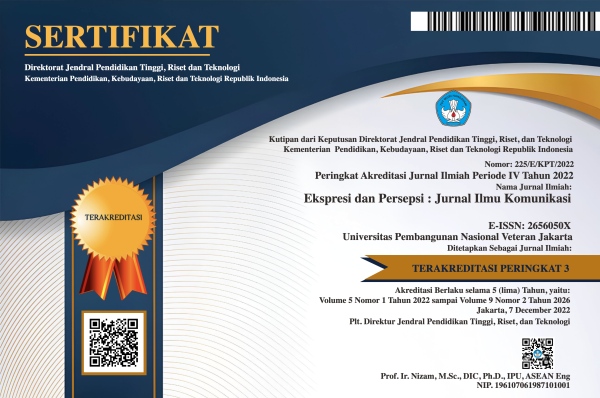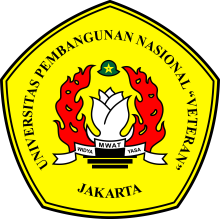KOMUNIKASI ANGGOTA KELUARGA UNTUK PENGASUHAN ANAK CEREBRAL PALSY
DOI:
https://doi.org/10.33822/jep.v6i3.6179Keywords:
KOmunikasi Keluarga, Komunikasi konvergen, Cerebral Palsy, Pengasuhan, Proses interaksiAbstract
Pengaruh komunikasi anggota keluarga untuk pengasuhan anak cerebral palsy terdiri dari : pengaruh proses interaksi terhadap interaksi; pengaruh tindakan dukungan terhadap dukungan sosial; pengaruh komunikasi anggota terhadap komunikasi konvergen; pengaruh kesepakatan pengasuhan terhadap kualitas hidup orang tua; pengaruh orang tua terhadap anak; Pengaruh dukungan sosial terhadap kualitas hidup anak; Pengaruh interaksi terhadap hubungan komunikasi; Pengaruh hubungan komunikasi terhadap komunikasi konvergen; pengaruh komunikasi anggota keluarga terhadap proses interaksi; pengaruh orang tua terhadap anggota keluarga; pengaruh dukungan sosial terhadap komunikasi anggota keluarga; pengaruh komunikasi konvergen terhadap kesepakatan pengasuhan. Komunikasi anggota keluarga disukai oleh anak Cerebral Palsy yaitu kakak perempuan sedangkan tidak disukai oleh anak cerebral palsy adalah om atau bibi. Pengasuhan anak cerebral palsy paling sering dilakukan oleh angggota keluarga untuk kategori Cerebral palsy ringan dan Berat diasuh oleh Kakek-nenek; kemudian kategori Cerebral palsy sedang diasuh oleh kakak perempuannya sedangkan anggota keluarga yang jarang mengasuh diseluruh kategori Cerebral Palsy adalah Om-bibi.
References
Berns, R. (2012). Child, Family, School, Community: Socialization and Support. https://books.google.com/books?id=4SbovM1yyMAC
Chris Segrin, J. F., Segrin, C., & Flora, J. (2005). Family Communication. In Analysis (Vol. 53, Nomor 9). Routledge. https://doi.org/10.1016/j.patrec.2005.01.006
Creswell, J. W. (2018). Research and Design Qualitative, Quantitative and Mixed Methods Approaches. In Thousand Oaks California.
Duvall, E. M. (1988). Family Development’s First Forty Years. Family Relations, 37(2), 127. https://doi.org/10.2307/584309
Eherler, D., & Lehmann, T. (2001). Responder profiling with CHAID and dependency analysis. European Conference on Machine Learning, 12, 49–58.
Fawwaz, A., & Ramadhana, M. R. (2020). Pola Komunikasi Keluarga pada penyandang Disabilitas netra di SLBN A, Kota Bandung. e-Proceeding of Management :, 7(2), 4860–4875.
Fitzpatrick, M. A., & Koerner, A. F. (2006). Family communication patterns theory: A social cognitive approach. Engaging Theories in Family Communication: Multiple Perspectives, August 2017, 50–65. https://doi.org/10.4135/9781452204420.n4
Lawrence D. Kincaid, Monge, P. R., & Delia, J. G. (1987). Communication Theory - Eastern and Western Perspectives.
Mulyana, D. (2016). Pengantar Ilmu Komunikasi. Remaja Rosdakarya.
Pakula, A. T., Braun, K. V. N., & Yeargin-Allsopp, M. (2009). Cerebral Palsy: Classification and Epidemiology. Physical Medicine and Rehabilitation Clinics of North America, 20(3), 425–452. https://doi.org/10.1016/j.pmr.2009.06.001
Perdana, F. R. (2019). Peningkatan Kapasitas Pola Asuh Positif Orang Tua terhadap Anak dalam Keluarga Perkotaan. Jurnal Ilmiah Padma Sri Kreshna, 1(2), 7–12. https://doi.org/10.37631/psk.v1i2.72
Pozo, P., Sarria, E., & Brioso, A. (2011). Psychological Adaptation in Parents of Children with Autism Spectrum Disorders. A Comprehensive Book on Autism Spectrum Disorders, September 2011. https://doi.org/10.5772/18705
Richards, C. L., & Malouin, F. (2013). Cerebral palsy An Information Guide for Parents and Families. In Handbook of clinical neurology (Vol. 111). https://doi.org/10.1016/B978-0-444-52891-9.00018-X
Robert F. Bales, T. P. (1955). Family, Socialization and interaction process. The free press, Glencoe, Illinois.
Rohner, R. P., & Khaleque, A. (2014). Parental acceptance-rejection theory , methods , evidence , and implications. January 2012.
Ryff, C. D. (1989). Happiness is everything, or is it? Explorations on the meaning of psychological well-being. Journal of Personality and Social Psychology, 57(6), 1069–1081. https://doi.org/10.1037/0022-3514.57.6.1069
Sam Goldstein, R. B. B. (2013). Handbook of Resilience in Children. In Handbook of Resilience in Children: Second Edition. Springer New York LLC. https://doi.org/10.1007/978-1-4614-3661-4_3
Segrin, C., & Flora, J. (2011). family communication. In Family communication (Vol. 53, Nomor 9). Routledge.
Servaes, J. (2020). Handbook of communication for development and social change. In Handbook of Communication for Development and Social Change. https://doi.org/10.1007/978-981-15-2014-3
Sumardjo. (1999). Transformasi Model Penyuluhan Pertanian Menuju Pengembangan Kemandirian Petani (Kasus di Propinsi Jawa Barat) [disertasi] (hal. 1–372).
Downloads
Published
Issue
Section
License
Copyright (c) 2023 Resman Muharul, Djuara P Lubis, Herien Puspitawati, Pudji Muljono

This work is licensed under a Creative Commons Attribution-NonCommercial 4.0 International License.














